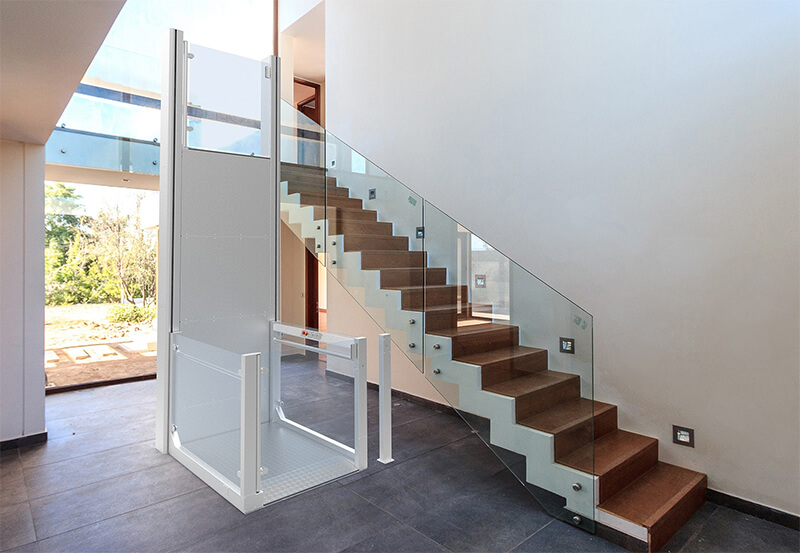What is a Passenger Lift?
أ مصعد الركاب is probably the picture that comes to mind when the word “lift” is mentioned. That’s because they are generally more popular due to their widespread use in transporting passengers in a variety of buildings.
They are mostly enclosed and can accommodate multiple people. The load capacity of passenger elevators is 450-1600kg and the passenger capacity is 6-20 people, depending on various factors such as the design standard of the elevator, the size of the car, the motor power, the materials used, etc.
Passenger lifts are typically faster with speed ranging from 1 to 2.5 m/s depending on the building height, and lift type.

Design and Features of a Passenger Lift
The design of a مصعد الركاب features a durable lift shaft that securely houses both the passenger car and the mechanical components required for its operation. To ensure smooth vertical movement, the lift must be built to precision to accommodate its operation.
The following are the key design components:
- The lift shaft must be designed to handle the weight of the car, passengers, and mechanical forces
- Guiding rails are installed inside the shaft to prevent the lift car from going off track. This ensures safe and efficient movement between the floors.
- Depending on the design of the lift, the motor and pulley system are typically housed either in a separate machine room above or below the shaft or housed within the shaft if it is a machine-room-less lift.
- To protect the passengers and prevent accidents in case of malfunction, the lifts must be equipped with safety features such as emergency brakes, buffers, and emergency exit points.
- The control panels are typically designed for easy access to the shaft, allowing for easy routine maintenance and emergency.
- The lifts are designed to meet safety regulations by installing fire-resistant materials, emergency lighting and providing adequate ventilation to prevent overheating of equipment.
Building Regulations and Compliance
- The regulations that govern passenger lifts varies from country to country, but generally they focus on the design, safety, accessibility, and installation.
- The UK lift regulations 2016 require safety conformity and accessibility, especially for wheelchair users, under part M of the regulations.
- The guidelines for design, operation, and maintenance of passenger lifts in the USA is governed by ASME A17.1/CSA B44 (Safety Code for Elevators and Escalators). The regulation also covers safety features such as fire protection and emergency operations. Also, the Americans with Disabilities Act (ADA) requires lift to meet accessibility standards, ensuring it can accommodate people with disabilities.
- In China, the design of elevator lifts must be compliant with the GB 7588 (Safety Rules for the Construction and Installation of Lifts), which covers safety, emergency features, and maintenance requirements.
- The Australia Disability Discrimination Act (ADA) ensures lifts are accessible to people with disabilities while the AS 1735 (Lift Standards) governs the design and operation of passenger lifts, covering structural integrity, fire safety and accessibility.
- The building standard law of Japan regulates elevator safety, including earthquake resistance, due to the high likelihood of seismic activity in the region.
- The Indian Standard IS 14665 governs the installation, design, and safety of lifts.
- Make sure to determine your country’s specific regulations to avoid non-complaint issues.
What is a Platform Lift?
A platform lift also does the job of vertical transportation between different floors, but primarily designed for people with mobility issues. It can accommodate one person or one wheelchair user, with a maximum capacity of up to 5 people. It operates over short distances and it’s not as fast as passenger lifts.
The common speed for platform lifts is 0.15 m/s. At this speed, the lift can travel from one floor to the other in about 22 seconds on average. However, 0.15 m/s is not a universal standard; the speed of platform lifts can range from 0.1-0.15m/s, while inclined platform lifts may have a slightly different range due to the staircase design. Adjustments in the speed are mostly due to the installation needs of the environment.

Building Codes and Regulations
Similarly to passenger lift building codes and regulations, platform lift regulations differ from country to country, but they generally address safety, accessibility, and installation standards.
- According to The American Disabilities Act, platform lifts must meet accessibility standards for people living with disabilities. The ASME A18.1 specifies the safety Standard for Platform Lifts and Stairway Chairlifts, while the International Building Code regulates where the platform lifts can be installed.
- In the United Kingdom, the BS 6440:2011 governs the standards for Powered Lifting Platforms for Use by disabled persons and Part M of the building regulations requires buildings to be accessible to all, which is often fulfilled by installing platform lifts in environments where full-sized elevators are not practical.
- The European Standard EN 81-41 governs the installation of vertical and inclined platform lifts for persons with reduced mobility. In Canada, CSA B355 regulates safety standards for lifts for with physical disabilities.
Key Differences Between Passenger Lifts and Platform Lifts
| Factor | Passenger Lifts | Platform Lifts |
| Purpose | For transporting multiple passengers in a building. | Suitable for high-rise building with long distances, Up to 40 meters |
| سرعة | Faster, typically, about 1-2.5 m/s | Slower, typically around 0.1 – 0.15 m/s |
| سعة | Larger capacity, typically up to 8-20 people or more. | Smaller capacity, typically 1-2 people or a wheelchair |
| Travel Distance | Suitable for low-rise buildings with shorter distances, Below 12 meters | Suitable for low-rise building with shorter distances, Below 12 metres |
| Enclosed Structure | Typically, fully enclosed car with automatic doors | It can be open or enclosed depending on the model |
| Accessibility | Requires specific design to accommodate people with disabilities. For instance, larger car or controls installed at accessible heights. | Specifically designed to accommodate people with disabilities and wheelchairs. |
| تثبيت | Requires a dip pit for installation | Often design with low pit or no pit at all. Easier to install. |
| Installation cost | More expensive due to complex installation and higher capacity. | Generally, less expensive due to its simpler design and lower capacity. |
| Applications | Common in commercial, residential, and public buildings | Typically used for homes, schools, buildings with accessibility needs |
| Frequency of use | High Usage | Low Usage |
| Service life | 15-20 year | 10-15 year |
| Regulations | Governed by more stringent elevator codes and standards, such as EN 81-20/50, ASME A17.1). | Governed by platform lift specific standards (e.g., EN 81-41, ASME A18.1). |
Factors to Consider When Choosing Passenger Lift and Platform Lift
Building Height and Travel Distance:
- Passenger Lifts: Ideal for high-rise buildings or multiple floors.
- Platform Lifts: Designed for shorter distances (1-3 floors).
Capacity Requirements:
- Passenger Lifts: Suitable for vertical transportation of multiple people at once.
- Platform Lifts: Typically accommodate 1-2 people or a wheelchair.
Space Availability:
- Passenger Lifts: Require significant space for a lift shaft, pit, and machine room.
- Platform Lifts: Require less space, usually without a need for a deep pit or machine room. This makes them easier to install in smaller spaces.
Accessibility Needs:
- Passenger Lifts: they are more versatile, and not specifically designed for wheelchair access.
- Platform Lifts: Specifically designed for wheelchair users and those with mobility issues.
سرعة:
- Passenger Lifts: Operate at higher speeds, 1-2.5 m/s. This makes them suitable for environments with high foot traffic that require fast movement between floors.
- Platform Lifts: Slower speeds, about 0.1-0.15 m/s, ensuring safety and stable transport for individuals with mobility challenges.
Installation and Cost:
- Passenger Lifts: Due to the complexity of installation, it typically more expensive.
- Platform Lifts: Generally, less expensive, with simpler installation.
خاتمة
Both Passenger lifts and Platform lifts are designed for vertical transportation between different floors, but they have varying purposes which guide how to choose between the platform lift and passenger lift. Where speed, traffic flow and capacity are the primary considerations, passenger lift would be the ideal choice. However, where accessibility is the core issue especially for people with mobility challenges, the platform lift is a good choice especially for low-rise buildings.
If you need an expert advice on the ideal lift for your building, contact Dazen today and we will respond within 48 hours.
